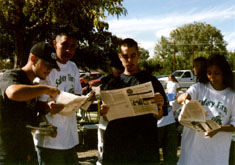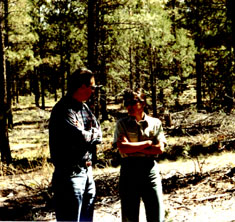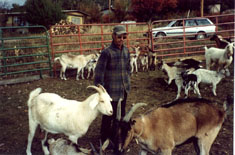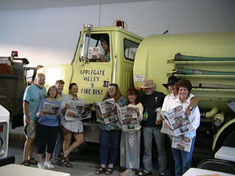 |
|
|
Volume VII |
November 2002 |
Number X |
|
|
Spañapalooza: Getting the Youth Together in EspañolaNew Southwest Regional Forester Meets with Community People and Local Forest Service Personnel in Truchas By Mark Schiller and Kay Matthews |
Puntos de Vista: New Strategies and Collaboration on Treaty Rights By Moises Gonzales, Mexicano Land Education and Conservation Trust Ray Pacheco's "Value-Added" Goats By Mark Schiller Editorial: Water, Otra Vez By Kay Matthews |
|
Puntos de Vista: New Strategies and Collaboration on Treaty RightsMoises Gonzales, Mexicano Land Education and Conservation Trust On September 22nd of this year, Chicano land- based communities took a new approach in advocating for protection of rights under the Treaty of Guadalupe Hidalgo. During the New Mexico Acequia Association (NMAA) annual meeting in Taos the general membership approved a resolution that established a framework for working with community land grant organizations in recognition of land and water rights protected by the Treaty. The resolution approved by NMAA calls for the organization to collaborate with the New Mexico Land Grant Forum and the Mexicano Land Education and Conservation Trust in development of a strategy to enforce community land, water, and cultural use protections. In addition, the resolution states that the organizations collaborate to include water right protections in any remedy that addresses the Treaty of Guadalupe Hidalgo. In recent years the efforts of the NMAA have lead to an increased awareness of the social and cultural importance acequia water rights play in the sustainability of the land-based culture of New Mexico. The organizational efforts of acequias has so profoundly impacted the political process that candidates for local and state offices must now address acequia issues as part of their political agendas. Similarly, the New Mexico Land Grant Forum was organized in the early 90s in order to demand that Congress address the loss of land grant land as part of its political agenda. By the end of the decade senators Domenici and Bingaman implemented a process to evaluate whether the federal government properly adjudicated land grant claims. Representative Tom Udall of the third congressional district of New Mexico introduced legislation known as the Mexican American Land Claims Act, which would establish a commission appointed by the president to evaluate land grant claims on a case-by-case basis. The new millennium has seen acequias and land grant issues as major conversation topics at the dinner table, weddings, and first holy communions in Indo-Chicano families throughout Northern New Mexico. In May of 2002 the Mexicano Land Education and Conservation Trust emerged as another organization that promotes land and water right protection under the Treaty of Guadalupe Hidalgo. The organization's goal is to develop a broad-based membership throughout land grant communities in New Mexico and southern Colorado to influence the legislative and political process. The organization has already started working toward this goal by hosting educational events that are intended to mobilize community land grants as well as youth. The Trust has been involved in organizing efforts in the Santa Cruz, Pueblo Quemado, Juan Jose Lovato, Juan Montes Vigil, Trampas, San Sebastian Martin, Carnuel, Chilili, and Cundiyo land grants, just to name a few. However, efforts by this new organization to achieve its full political capacity will require collaboration with other organizations. A fully organized acequia and land grant movement in New Mexico could radically change the political process in New Mexico. For example, let's look at Rio Arriba County. The total population of the county is approximately 41,000, with only about 7,000 people living within the City of Española. The majority of the population is situated in the unincorporated villages throughout the county on irrigated agricultural lands adjacent to BLM or Forest Service lands that were taken from the community land grants. In Rio Arriba County alone, where Indo-Chicano people make up 76 percent of the population, I would estimate that at least 20,000 people are dependent on the acequia system for income and subsistence. Add the political potential of parciantes in Mora, Taos, San Miguel, Sandoval, Santa Fe, Guadalupe, Cibola, and East Bernalillo County and you can just imagine the potential political power. I would estimate that at a minimum 100,000 people are connected and have an interest in sustaining the acequias and ensuring that land grant lands are returned so that we will no longer be forced to build on our irrigated farmland. The question our communities must ask themselves is, does our political power exist to protect existing political interests or does our power exist to support our own interests first? I would like to think that our power exists to support our own interests, but in reality we are not organized well enough to fully impact policy at the state and federal level. When we are organized and mobilize village to village, then the government will not think in terms of "should we recognize your water rights or your land claims" but will finally be forced to respect the use of our water and return the land that sustains the culture and resources of northern New Mexico. Editor's note: For more information regarding the Mexicano Land Education and Conservation Trust you can contact Moises Gonzales at 927-0402. Ray Pacheco's "Value-Added" GoatsBy Mark SchillerIn order to make a living off the land one has to have an vast array of skills and be extraordinarily resourceful. Ray Pacheco, who lives with his wife, Evelyn, in Las Trampas, is a farmer, rancher, logger, wood miller, furniture maker, and vintner. In August of this year he added "noxious weedologist" to his resume. That's when he increased his herd of four pet goats to 26 and stopped thinking of them as pets and started referring to them as "lean, mean, eating machines."
In the late spring Pacheco attended a seminar sponsored by the Taos Soil and Water Conservation District and the Quivira Coalition with Lani Lamming, who'd brought a herd of 600 goats from Wyoming to Taos to do a noxious weed control pilot project (see La Jicarita, June 2002). Lamming explained that she and her children were no longer able to make a living cattle ranching and had started a successful business using goats to eradicate the noxious weeds that are destroying grasslands throughout the west. "That meeting really inspired me," Pacheco told La Jicarita News. He began looking around the area for more goats. Chris Folkmer, who raises dairy goats and lives in the neighboring village of Ojo Sarco, was willing to sell Ray 20 goats and the experiment was up and running. Forming a partnership with Jake Martinez and Catherine Wayne, who stay with the goats and do most of the herding, Pacheco contracted with Roy Martinez of Ranchos de Taos to do a 15 day "experiment" on three acres of Martinez land that was infested with Russian knapweed and Canada thistle. Before putting the goats on the land, they spread a mixture of grass seeds throughout the area and then turned the goats loose. They "mowed down the weeds" and stomped the grass seeds into the soil. "When the rains came the grass sprouted and caught," Pacheco explained. "It looked beautiful. We'll probably have to go in there at least one more time next year to completely eradicate the weeds, but I think we were all pleased with the success of the project." Pacheco has already spoken with Peter Vigil, director of Taos Soil and Water Conservation District, about doing some projects next year in conjunction with his office, including Fred Baca Park in the town of Taos. Pacheco, Martinez, and Wayne currently use metal fencing panels to keep the goats confined to the weed-infested areas, but Pacheco feels the panels are difficult to work with and wants to start using electric fencing instead. "Electric fencing is very lightweight and mobile," he explained, "and once the goats get used to it, it makes the set up and herding much easier." The herd currently includes 21 females and five males. Pacheco hopes most of his females will give birth to twins in the spring. He also plans to buy more goats and envisions a herd of about 100 for next year. "I figure 100 goats can do about one acre a day depending on how dense the weeds are." He says that his price per goat per day ranges between one and two dollars depending on the number of goats involved and the condition of the area being treated. In addition to increasing his own herd, Pacheco has spoken with Lamming about breeding goats for her. Pacheco's herd is Alpine Dairy goats, but Lamming raises Cashmere goats, so that along with her weed operation she can sell their highly prized wool. If all goes well Pacheco will take two to three hundred of Lamming's goats over the winter and keep them penned separately. This will help supplement his income and give him needed experience with a larger herd. "Goats prefer weeds and tree saplings to alfalfa and grass," Pacheco explained. "When I first realized that, I began going over to the acequia and cutting all the junk that we have to deal with when we clean the acequia in the spring. The goats loved it and, of course, it reduced my feed costs." He pointed out that goats eat salt cedar and willows, making them a good fit for eliminating these species along streamsides. If we're going to keep farming and ranching an economically viable way of life, we have to find creative ways to add value to the resources we already possess. People like Ray Pacheco demonstrate the kind of energy and resourcefulness that's revitalizing land-based livelihoods in northern New Mexico. For further information you can contact Ray at 689-2566. Editorial: Water, Otra VezBy Kay MatthewsI recently heard a spokesman for the Alliance for the Rio Grande Heritage, who was articulate and well informed, express the need for all stakeholders - urban residents, farmers, ranchers, and environmentalists - to work together to conserve and share our water resource in an equitable fashion. At the same time, a coalition of environmental groups (some of which are members of the Alliance) filed suit to force the release of San Juan-Chama water from northern reservoirs to keep the silvery minnow alive. To get to the bargaining table, the environmentalists rationalize, they are forced to "get the attention" of the stakeholders by suing them. The intervenors in this lawsuit - Albuquerque, Santa Fe, the Middle Rio Grande Conservancy District (MRGCD), the state of New Mexico - disagree with this assessment, of course, citing the collaborative efforts that have been made to find a solution, which led to A Memorandum of Understanding between the various stakeholders signed in 2000 (federal and state agencies, the MRGCD, the Alliance for the Rio Grande Heritage, and Albuquerque). Considering the complexity of the water situation and the enormity of the bureaucracies involved in the process, the environmentalists may be correct in asserting that it's going to take more drastic measures than a Memorandum of Understanding to get the city of Albuquerque to actually do something to address its uncontrolled growth and lack of water conservation and the MRGCD to clean up its bureaucratic mess and deliver water efficiently and fairly to basin farmers. However, when push comes to shove, it's unlikely that junior water rights holders like Albuquerque are the ones that are going to be in jeopardy of losing their water. We've already seen a priority call on an acequia in the Rio de Chama Acequia Association (which disputed its adjudicated priority date) and the buying up of agricultural water rights in the Pecos watershed in southern New Mexico to help meet water obligations to Texas. State Engineer Tom Turney is reluctant to make a priority call on junior water rights on the Pecos that might affect urban areas, and many environmentalists consistently bemoan the fact that norteño parciantes are generally the ones with the oldest priority dates. They support the notion that the "highest and best" use of our water is for urban, environmental, and recreational use. As water rights attorney David Benavides points out in a letter to the editor of Grist Magazine, the "first-in-time, first in line doctrine . . . is one of the few that actually benefits poor communities. . . . These community irrigation systems are the only remaining models in this region of the type of community-based, democratically-managed, small-scale local food production" that are resistant to the commodification of water in the free markets of agribusiness and globalization. Yet the state engineer, cities, and environmentalists seem intent on making them vulnerable to market demands by pushing for adjudication, which defines these community rights as private rights. Several western states, including Colorado, are talking about overhauling the priority system to "place a greater priority on urban water needs rather than agriculture." Instead of talking about urban water conservation and limits to growth, they use distorted agricultural diversion percentages to make it seem like our farmers and ranchers are wasting all the precious water that should be directed to the "highest and best" uses: urban, commercial, recreation. As Moises Gonzales states in this issue's Puntos de Vista, it is time for us to consolidate our power and employ all our strategies, village by village, to keep people on the land and resources in our communities.
|
Home | Current Issue | Subscribe | About Us | Environmental Justice | Links | Archive | Index
Copyright 1996-2002 La Jicarita Box 6 El Valle Route, Chamisal, New Mexico 87521.







 J.D.
Rogers, editor of the Applegator, and Jack Shipley, chair of
the Applegate River Watershed Council
J.D.
Rogers, editor of the Applegator, and Jack Shipley, chair of
the Applegate River Watershed Council  Volunteers
who assist with the bulk mailing process for 8,000 Gators
every other month
Volunteers
who assist with the bulk mailing process for 8,000 Gators
every other month